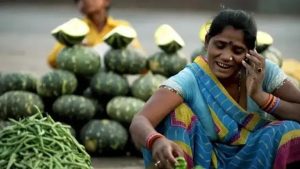Finding Replicable Solutions To Women’s Livelihood Challenges

Image Source: Development News
Evidence based research has developed a strong case for mobile phones aiding in women’s entrepreneurial ventures. With a mobile handset and an active internet connection, women get 24/7 access to worldwide e-business channels, which can be operated from anywhere in real time (Hilbert, 2011). It can also be a valuable tool for the organisation and mobilisation of women’s advocacy and interest groups (Nath, 2006). Mobile internet opens up new avenues for education, communication and information sharing; and improves market access for women entrepreneurs. It also provides women autonomy in financial decision-making through access to financial products, and improved financial literacy levels.
While these merits and others are widely agreed upon, there is a glaring digital divide in mobile phone ownership and the use of mobile internet in India, with only 42 percent adult men and 21 percent adult women using mobile internet (GSMA Intelligence Consumer Survey, 2019). Further, as we welcome the fifth generation technology for mobile cellular networks (popular as 5G), over 43,000 Indian villages live in digital darkness, with no access to mobile networks. This map below shows the state-wise levels of digital darkness– number of villages without network as a percentage of total inhabited villages in a state (Source: Data.gov.in).

Lack of coverage is a result of a basic economic conundrum — developing infrastructure in rural or geographically inaccessible regions can be twice as expensive, while revenue opportunities are as much as ten times lower (Touchard, 2016). High cost of deploying infrastructure in these areas, combined with a weak demand for mobile internet service, results in a supply-demand equilibrium with low population coverage. It is ironic that investing in these areas of ‘low economic potential’, can be transformational to their growth and development into viable markets.
For rural women seeking to secure a livelihood, this access challenge is exacerbated by other social, financial, and market related obstacles (Bose & Das, 2014; Sudarshan & Bhattacharya, 2009; Handy, Ranade & Kassam 2007). These multidimensional barriers have been studied in depth, and provide vital context for those who seek to ameliorate them. However, little is known about the heterogeneous profiles and personalities of these rural women, which can dictate their adoption and usage of mobile technologies and how they search for or build their livelihoods. Further, groundbreaking work is being done by grassroot level organisations and state and local governments, in upskilling and supporting women run enterprises using ICTs even in the most testing circumstances; but the knowledge generated as a result of this work remains siloed within these agencies.
Our research seeks to understand the complex profiles of rural women entrepreneurs, and bring the work being done to support them to the forefront. We aim to identify successful, proven, and replicable use cases of mobile technology that can help women, especially those riddled with financial vulnerability, build sustainable enterprises that can uplift them and their communities.
References
Bose, N. & S. Das (2014). Women’s Reservation and India’s National Rural Employment Guarantee Scheme.
Handy, F., Ranade, B., & Kassam, M. (2007). To Profit or not to profit: Women entrepreneurs in India. Nonprofit Management & Leadership, 17(4), 383–401.
Hilbert, M. (2011). Digital gender divide or technologically empowered women in developing countries? A typical case of lies, damned lies, and statistics. http://dx.doi.org/10.1016/j.wsif.2011.07.001.
Nath, V. (2006). Empowerment of Women through ICT-enabled Networks: Towards the Optimum ICTimpact Model, in N. Hafkin & S. Huyer (eds.), Cinderella or Cyberella: Empowering Women in the Knowledge Society, Bloomaeld, CT: Kumarian Press.
Sudarshan, R.M. & S.Bhattacharya (2009).Through the Magnifying Glass: Women’s Work And Labour Force Participation in Urban Delhi. XLIV(48), 59–66.
Touchard, G., ‘Unlocking Rural Coverage: Enablers for commercially sustainable mobile network expansion’, GSMA, 2016.
This research was developed as part of the Bharat Inclusion Research Fellowship.
